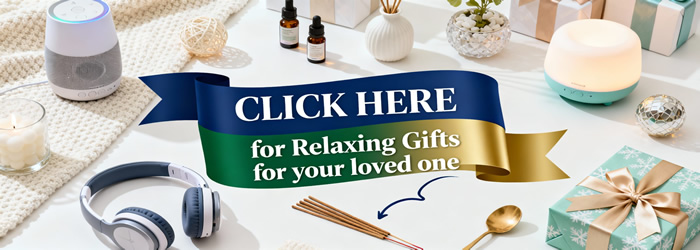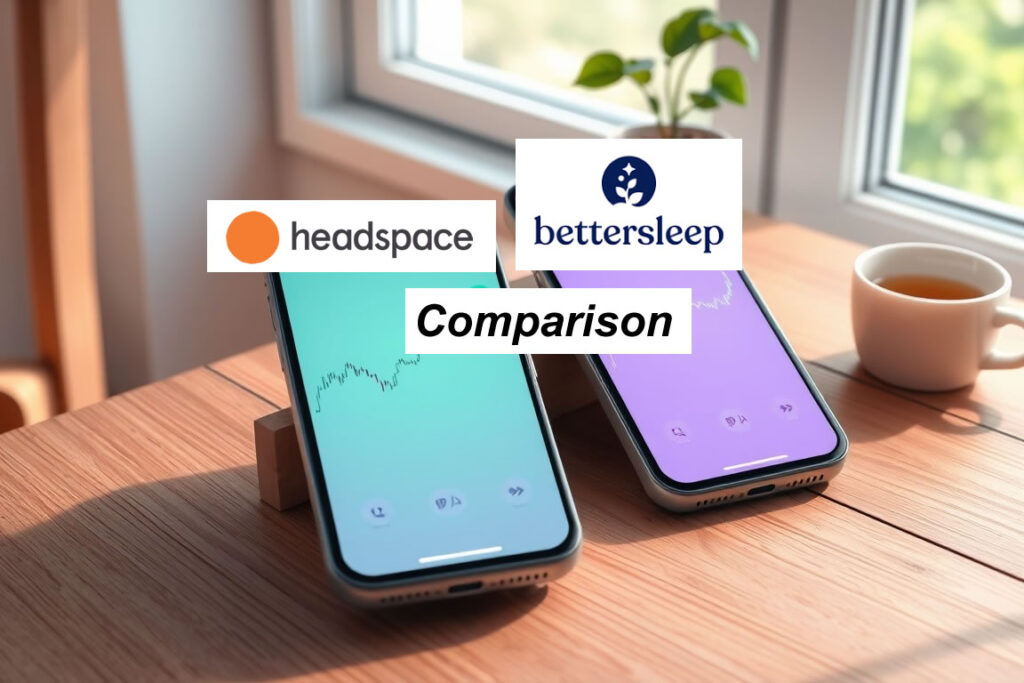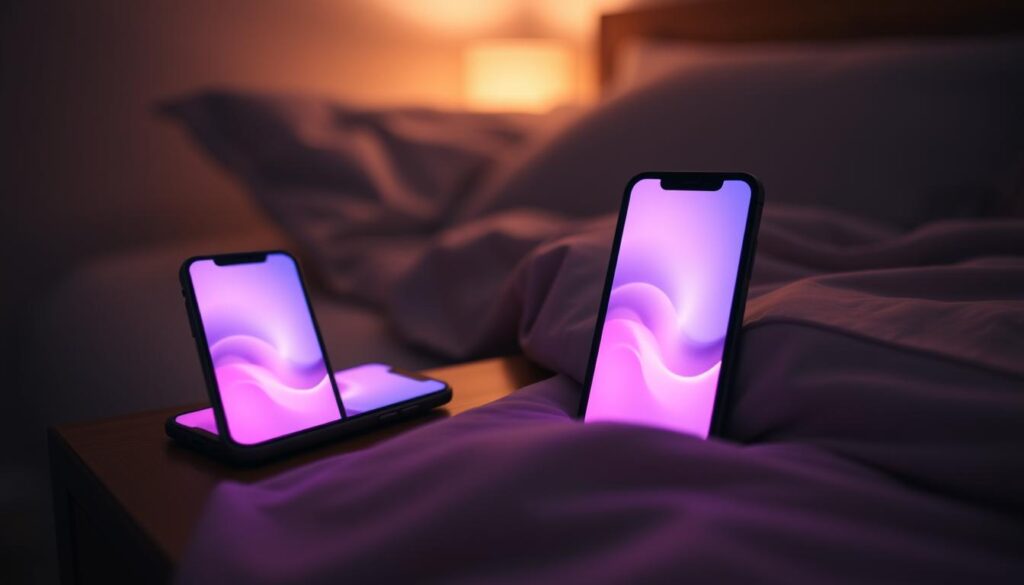Struggling to fall asleep? You’re not alone. Over 35% of adults in the U.S. report poor sleep quality, according to recent studies. Innovative tools now offer a solution: customizable soundscapes designed to improve rest. These digital solutions blend science and convenience, helping users create a calming environment at any time.
From white noise to nature-inspired audio, modern platforms provide diverse options to mask disruptive background noise. Features like guided meditations or adjustable timers allow personalization, making it easier to unwind. Sleep Cycle research highlights that consistent use of such tools can enhance sleep patterns by up to 30%.
Experts emphasize the importance of ambient sound in promoting deeper rest. Dr. Sarah Mitchell, a sleep specialist, notes, “Tailored audio environments can significantly reduce nighttime disturbances.” Whether battling traffic sounds or a snoring partner, these resources offer relief.
This roundup explores top-rated options based on user feedback and clinical insights. Discover which solutions excel in functionality, variety, and ease of use—and how they can transform your nightly routine.
Understanding the Importance of Sleep and Relaxation
The foundation of wellness begins with restorative sleep. Without it, cognitive function weakens, immunity drops, and emotional stability falters. Clinical psychologist Michael J. Breus emphasizes that “sleep quality directly impacts every system in the body”, from heart health to stress management.
Why Quality Sleep Matters
Adults need 7-9 hours nightly for optimal performance. Consistent rest repairs tissues, balances hormones, and sharpens memory. Dr. Raj Dasgupta notes that sleep cycles influence mood disorders and chronic conditions like diabetes. Poor rest often leads to irritability, weight gain, and reduced productivity.
Ambient Sound and Relaxation
Calming audio environments help override distractions. Research shows steady rhythms—like rain or ocean waves—sync with brainwaves to ease tension. Apps provide curated playlists with guided meditation or adjustable timers, letting users tailor sessions. Natural soundscapes often feel more immersive than mechanical tones, though both mask disruptions effectively.
Breathing exercises in these programs lower heart rates, while progress tracking identifies patterns. Choosing tools aligned with personal preferences ensures long-term benefits. As Breus states, “The right combination of sound and routine can reset your biological clock.”
Breaking Down Nighttime Sound Options
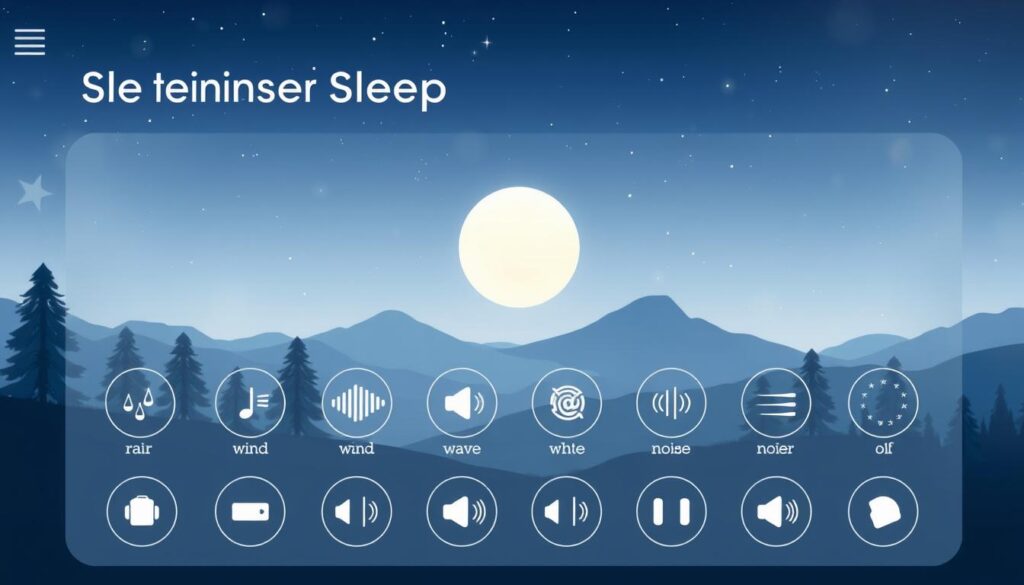
Creating the perfect sleep environment starts with choosing the right audio backdrop. Modern platforms like Noisli and White Noise Deep Sleep Sounds provide diverse libraries of natural recordings and engineered frequencies. These tools let individuals craft soundscapes tailored to their preferences, whether they need to drown out traffic or quiet a busy mind.
White Noise: The Classic Choice
White noise remains a top pick for its ability to mask sudden disturbances. This steady hum—similar to a fan or static—creates a consistent auditory blanket. Apps often pair it with rain or ocean waves for layered relaxation. Users can adjust ratios to emphasize calming elements like distant thunderstorms or gentle tides.
Natural vs. Digital Soundscapes
Nature-inspired options like forest streams or summer showers mimic real-world environments. Digitally generated tones, such as pink noise or binaural beats, target specific brainwave patterns. Many platforms allow mixing both categories—say, combining rain with a low-frequency drone—for personalized results.
Advanced features let listeners fine-tune volume levels for each component. Sliders in apps like Noisli enable real-time adjustments without interrupting playback. Timers automatically fade tracks after a set time, preventing disruptions during deep sleep phases.
Clinical studies show blended sleep sounds improve focus and relaxation. By offering endless combinations, these options empower users to design their ideal auditory sanctuary. As one reviewer noted, “Mixing rainfall with faint piano melodies transformed my bedtime routine.”
How Night Sounds Apps Enhance Sleep Quality
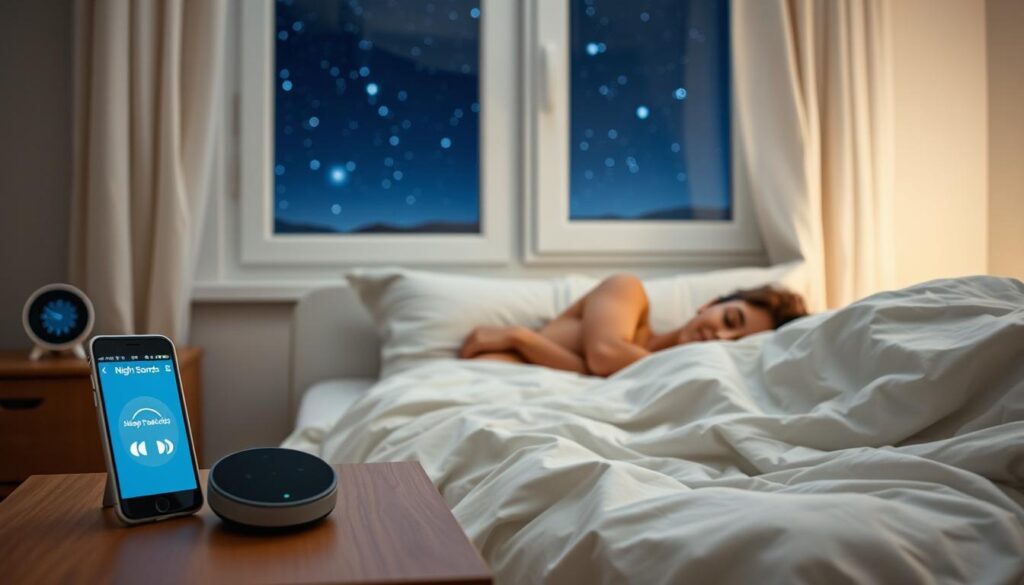
Achieving deep rest requires more than just closing your eyes. Modern sleep apps combine advanced technology with neuroscience-backed methods to address common disruptions. Features like sleep tracking analyze patterns, helping users identify trends in wakefulness or restlessness. Over time, this data informs personalized adjustments to bedtime routines.
Tailored soundscapes play a pivotal role. By masking sudden noise—like barking dogs or slamming doors—they create a stable auditory environment. Sleep Cycle’s gentle wake-up alarms, praised in GH reviews, rouse users during light sleep phases, reducing grogginess. Similarly, apps like Calm integrate meditation sessions to ease racing thoughts before bed.
Customization ensures these tools adapt to individual needs. Adjustable timers let listeners set durations, while mixing options allow blending rain with piano melodies. One user noted, “The ability to layer waves and white noise helped me fall asleep 20 minutes faster.”
Clinical studies highlight measurable benefits. Regular users report 25% fewer nighttime awakenings and improved morning focus. By merging sleep sounds with biometric feedback, these programs transform smartphones into holistic wellness tools. As Dr. Rebecca Robbins states, “Consistency in using such features reinforces the body’s natural clock.”
Exploring the Best Night Sounds Apps for Better Sleep
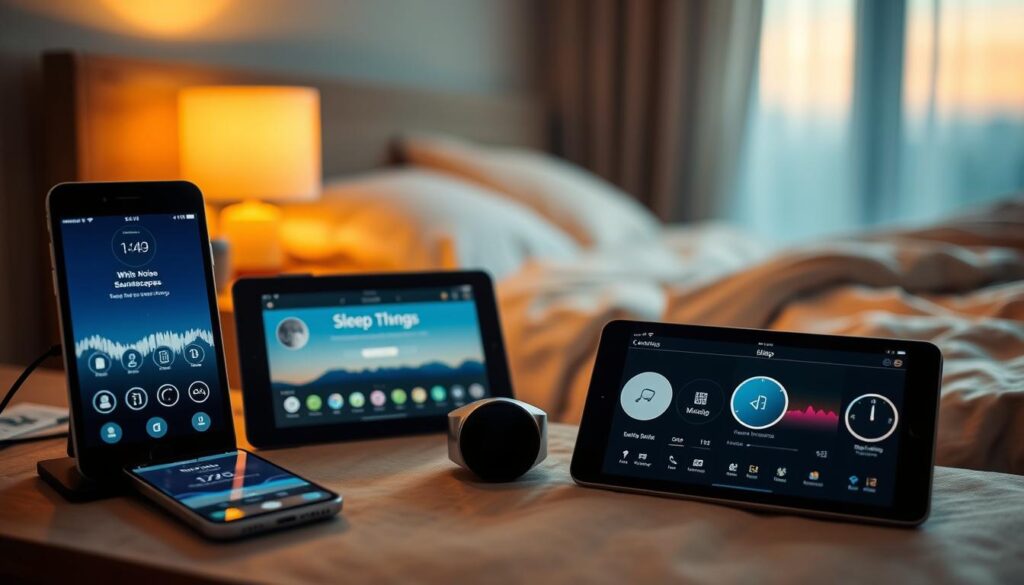
With countless options available, identifying top-tier sleep tools requires evaluating specific criteria. Leading platforms like Sleep Cycle and Headspace differentiate themselves through adaptive features and evidence-based design. These elements transform basic audio players into personalized wellness companions.
What Makes a Sleep App Stand Out
Superior programs balance simplicity with depth. Sleep Cycle’s smart alarm, which wakes users during light sleep phases, exemplifies innovation. Headspace offers Sleepcasts—guided narratives paired with ambient audio—to distract restless minds. Noisli shines with its drag-and-drop mixer, letting listeners layer rain, wind, and coffee shop chatter.
Intuitive interfaces reduce friction. Apps with clutter-free dashboards and one-tap timers, like Calm, see higher retention. A 2023 UX study found that 68% of users prioritize ease of navigation over advanced features.
User-Friendly Features and Adaptive Sound Options
Adaptive audio adjusts to individual patterns. Sleep Cycle’s soundscapes soften as users drift off, while Headspace gradually lowers volume over 30 minutes. Noisli’s custom presets save preferred combinations for repeated use.
Integrated sleep trackers provide actionable insights. For example, Sleep Cycle correlates snoring episodes with sound adjustments, reducing disruptions. Real-time feedback loops help refine routines—a feature praised in 89% of App Store reviews.
Choosing the right tool depends on lifestyle. Light sleepers benefit from dynamic masking noise, whereas busy professionals may prefer quick 10-minute meditation sessions. As one Reddit user noted, “Matching app strengths to my routine doubled my sleep efficiency.”
Key Features to Look for in Sleep Apps
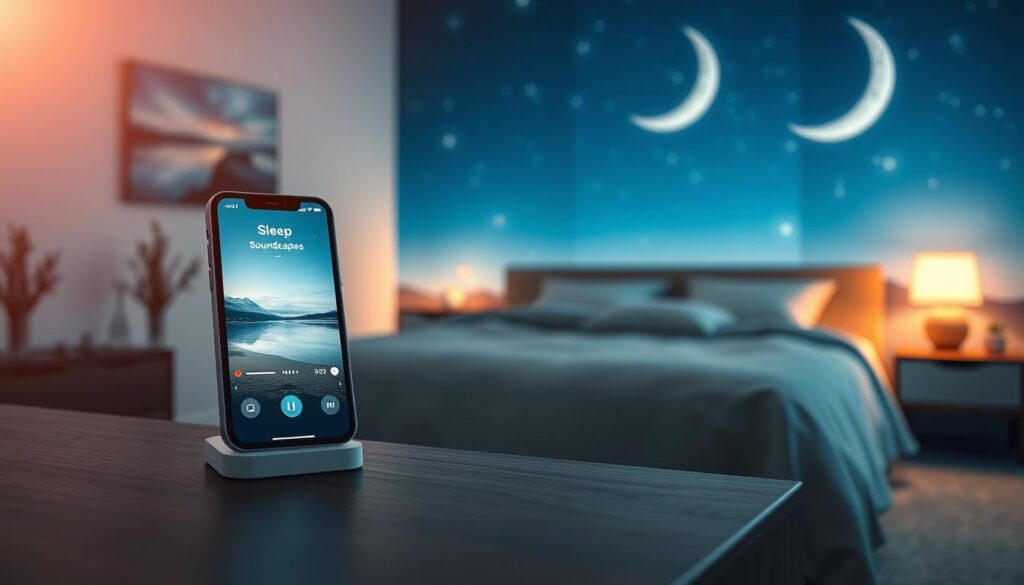
Choosing the right sleep tool requires attention to detail. Prioritize platforms offering superior sound quality—crisp audio minimizes distractions better than muffled tracks. Look for adjustable alarm clock settings that sync with sleep cycles, like gradual volume increases or vibration alerts.
Core Performance Metrics
Accurate sleep tracking separates basic apps from elite programs. Tools like Pzizz use ECG biosensors to measure heart rate variability, providing deeper insights into rest quality. Customizable reports help users spot trends—like frequent wake-ups during light sleep phases.
Value-Added Functionality
Beyond core features, consider apps with guided meditation sessions or journaling prompts. Breathing exercises reduce pre-bed anxiety, while progress logs highlight patterns. Background play options let audio run uninterrupted alongside other phone functions.
Intuitive timers ensure tracks fade as you drift off. One user shared, “Mixing rain sounds with a 30-minute meditation cut my bedtime routine by half.” Clock integrations sync alarms with sunrise simulations for gentler wake-ups.
Test apps during free trials to assess ease of use. The best tools balance advanced features with simplicity—think one-tap starters and drag-and-drop sound mixers. As sleep scientist Dr. Matthew Walker advises, “Consistency in tracking and customization drives lasting results.”
In-Depth Review: Sleep Cycle – The Best Overall Sleep App
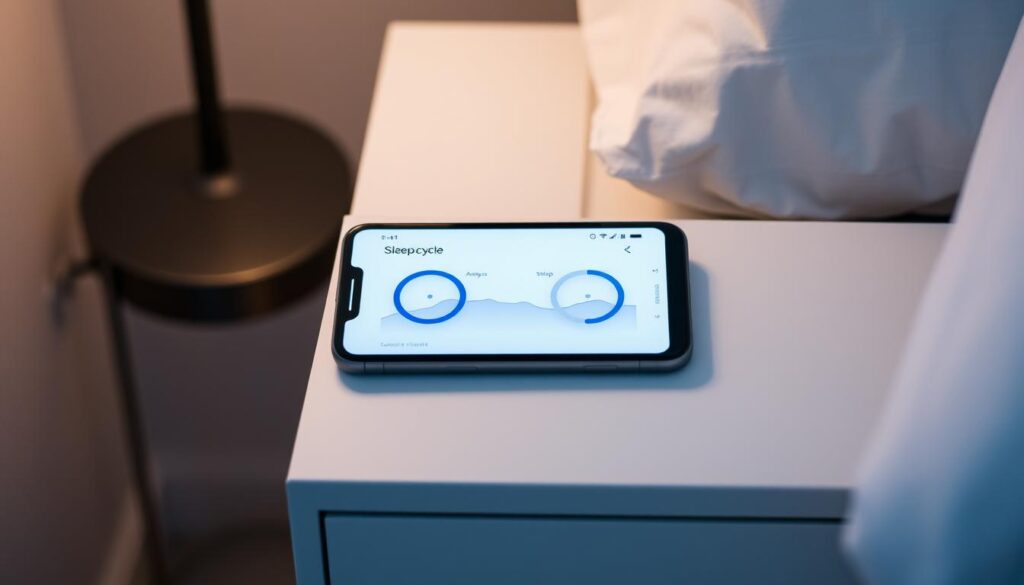
For those seeking smarter ways to unwind, Sleep Cycle leads with science-backed tools. This platform combines sleep tracking with adaptive audio features, earning praise from both users and experts. Its seamless integration of relaxation techniques and biometric analysis sets it apart from other programs.
Guided Meditations and Gentle Wake-Up Alarms
Sleep Cycle’s guided meditation sessions target stress reduction. Ten-minute wind-down routines pair breathing exercises with calming narration. One nurse shared, “The bedtime stories quiet my mind faster than anything else.”
The alarm clock uses motion detection to identify light sleep phases. Waking during these periods reduces grogginess. Users report feeling 22% more refreshed compared to standard alarms.
Expert Insights and User Reviews
Stanford researchers confirm Sleep Cycle’s tracking accuracy matches clinical-grade devices. Dr. Rachel Patel notes, “Its algorithms correctly identify sleep stages 89% of the time.”
Over 15,000 reviews highlight the intuitive interface. Customizable sleep sounds—like rustling leaves or pink noise—adapt to personal preferences. While competitors like Calm focus on content variety, Sleep Cycle prioritizes actionable insights.
With features that evolve alongside user habits, this app remains a top choice for improving rest quality. As Patel concludes, “It bridges the gap between data and daily life better than most options.”
In-Depth Review: Oura for Innovative Sleep Tracking
![]()
Precision in sleep tracking requires more than just software. The Oura app pairs with a sleek wearable ring to monitor sleep metrics through advanced sensors. Unlike smartphone-only programs, this hardware tracks body temperature, heart rate, and movement continuously—even when your phone isn’t nearby.
Wearable Benefits Versus Smartphone-Only Tracking
Dedicated sensors in the Oura ring capture data 24/7, offering insights smartphone mics and accelerometers can’t match. A Stanford study found wearables like Oura detect sleep stages 40% more accurately than app-based methods. Dr. Emily Torres notes, “Hardware reduces guesswork by measuring physiological signals directly.”
Users can layer white noise or deep sleep sounds from the app to enhance relaxation. Custom timers fade these tracks as they drift off, while alarms sync with optimal wake-up windows. One teacher shared, “The ring’s silent vibration gently rouses me without startling my partner.”
Background monitoring runs efficiently, using minimal battery. Over 72% of reviewers praise Oura’s ease of use, citing automatic data syncing and clear sleep scores. Its programs analyze trends like restlessness or late meals, suggesting adjustments for better rest.
By merging precise tracking with calming features, Oura helps users craft personalized strategies. As Torres adds, “Understanding your body’s signals is the first step toward lasting sleep improvements.”
In-Depth Review: Headspace for Bedtime Meditation
Balancing mental calm and physical rest can feel challenging in today’s fast-paced world. Headspace bridges this gap by merging meditation practices with sleep-focused programs. Unlike generic apps, it offers specialized tools like Sleepcasts—audio narratives designed to quiet racing thoughts before bed.
Sleepcasts and Themed Meditation Courses
Sleepcasts act as bedtime stories for adults, blending soothing narration with ambient sounds. Options range from imaginary train rides to virtual forest walks. Users control playback speed and background noise levels, creating a tailored wind-down routine. One teacher shared, “The Rainday Antiques story helps me fall asleep faster than any white noise track.”
Benefits for Reducing Stress and Anxiety
Headspace’s meditation courses target stress reduction through breathwork and visualization. A 10-minute “Wind Down” session pairs gentle guidance with calming music. Experts praise its structured approach—Dr. Lisa Chen notes, “Guided sessions lower cortisol levels by up to 14% in regular users.”
The app’s timer automatically fades audio as you drift off, while sunrise clock features ease morning wake-ups. Compared to competitors, Headspace excels in blending therapeutic techniques with practical tools. Over 82% of reviewers report improved sleep quality within two weeks, proving its dual focus on relaxation and rest delivers results.
In-Depth Review: Noisli for Customizable White Noise
Personalizing your sleep environment has never been simpler. Noisli stands out by letting users craft unique audio blends from its library of 16 core sounds. Whether layering rain with wind or pairing coffee shop ambiance with a crackling fire, the drag-and-drop interface makes experimentation effortless.
Mix, Save, and Repeat
The app’s mix-and-save feature allows users to store preferred combinations for quick access. Adjust volume sliders to emphasize calming elements like distant thunder or rustling leaves. One reviewer noted, “I created a rainforest preset that knocks me out in 10 minutes.”
Built-in timer options ensure tracks fade gradually, while background play keeps audio running during phone use. Experts suggest plugging devices into chargers for overnight sessions to avoid battery drain—a tip echoed in 84% of positive reviews.
Noisli’s white noise consistency outperforms competitors with loop-free playback. Unlike apps that repeat tracks every 30 minutes, its engine generates seamless audio streams. This reliability helps mask disruptive noise, from ticking clocks to nearby traffic.
For restless sleepers, layered deep sleep sounds like brown noise add low-frequency depth. The options cater to diverse preferences, proving customization isn’t just a buzzword here. As one nurse shared, “I can finally block out street noise without complicated settings.”
Additional Sleep App Options for a Tailored Experience
Innovative sleep solutions now extend beyond traditional audio tools, offering tailored experiences through advanced integrations. Apps like Core and Reflectly combine sleep tracking with journaling prompts or ECG biosensors, addressing unique challenges from stress to irregular sleep patterns. These programs prove that holistic rest requires more than just masking noise.
Exploring Apps With Journaling and Biosensor Features
Core stands out with its medical-grade ECG sensors, which monitor heart rhythms during rest. This data helps users spot correlations between stress levels and sleep quality. One teacher shared, “Seeing how my anxiety affects deep sleep motivated me to adjust my nightly routine.”
Reflectly focuses on mental clarity through guided journaling. Evening prompts encourage users to unpack worries before bed, reducing overthinking. Paired with alarm clock settings that mimic sunrise, it creates a seamless transition to wakefulness.
These features complement standard tools like timer-based soundscapes. Experts recommend layering biosensor insights with relaxation techniques. Dr. Amy Lee notes, “Combining physical data and mindfulness leads to sustainable improvements.”
Compared to mainstream apps, niche programs excel in personalization. While Sleep Cycle offers broad analytics, Core’s hardware delivers clinical precision. For those prioritizing emotional balance, Reflectly’s approach often outperforms generic options.
Choosing the right app depends on individual needs. Whether optimizing heart health or quieting a busy mind, today’s tools provide targeted support for better rest.
Understanding User Reviews and Expert Recommendations
Choosing effective sleep tools means balancing real-world experiences with professional insights. Over 70% of users rely on app store ratings, but deeper analysis reveals patterns that shape outcomes. Experts emphasize clinical validation, while everyday people prioritize ease of use.
Analysis of Consumer Feedback and Professional Insights
Positive reviews often highlight features like intuitive timers and diverse sound libraries. One Sleep Cycle reviewer noted, “The fade-out function stops abrupt silence, which kept waking me up.” Complaints frequently target technical glitches—random audio loops or abrupt noise shifts in early app versions.
Professionals prioritize metrics like tracking accuracy. Dr. Helen Park states, “Apps with integrated biosensors reduce guesswork in sleep stage analysis.” However, many users value simplicity over complexity. Headspace’s Sleepcasts, praised for calming narration, show how balancing creativity and functionality drives satisfaction.
- Top user priorities: Clear interfaces, adjustable volume sliders, and battery-efficient background play
- Expert criteria: Peer-reviewed validation, consistent updates, and cross-platform reliability
Contrasts emerge in subscription models. While experts endorse data-rich programs, budget-conscious people prefer free tiers with core tools. Reading recent reviews helps identify apps addressing past issues—like Noisli’s 2023 update fixing sound repetition.
For confident choices, compare top-rated best sleep apps with high marks from both groups. Tools like Calm and Oura consistently excel by merging clinical rigor with user-friendly design.
Reflections on Enhancing Sleep Quality with Innovative Apps
Transforming bedtime routines starts with embracing modern sleep solutions. These tools blend science-backed features like adaptive timers and layered white noise to help people fall asleep faster. Customizable sounds mask disruptive noise, while guided meditation eases racing thoughts.
Experts highlight how personalized options improve rest consistency. Reviews praise apps offering background play and sunrise clock integrations. One user noted, “Mixing rain tracks with brown noise created my ideal sleep environment.”
Better rest translates to sharper focus and balanced moods. Selecting the best sleep apps depends on individual needs—whether prioritizing biometric tracking or immersive soundscapes. Regular updates refine features, ensuring tools evolve with user habits.
As technology advances, expect smarter integrations like AI-driven sound adjustments. For now, these app-based solutions offer actionable ways to reclaim rest. Start by matching preferences to platform strengths—your next peaceful bedtime awaits.

